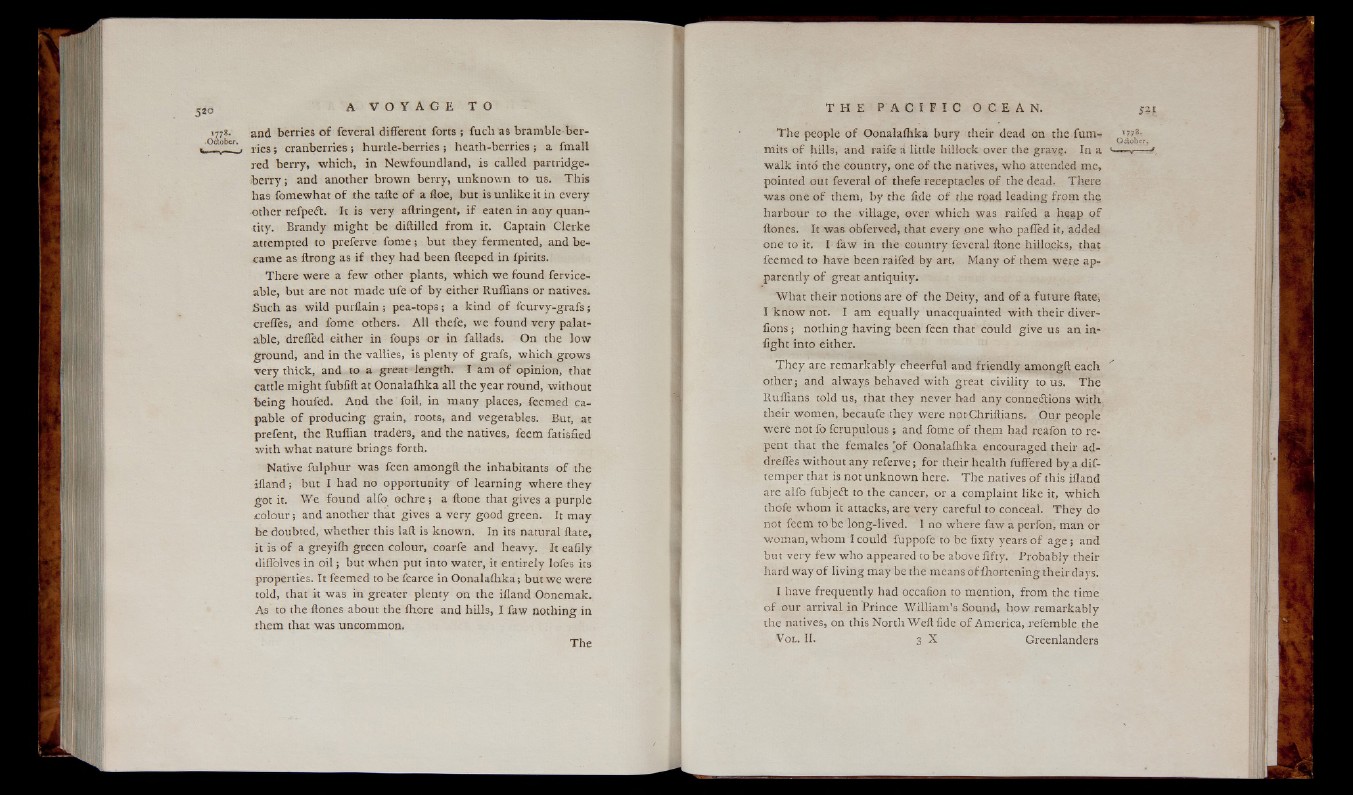
1778. and berries o f feveral different forts ; fuch as bramble-ber-
October., _ cranberries ; hurtle-berries ; heath-berries ; a fmall
red berry, which, in Newfoundland, is called partridge-
b e r r y ; and another brown berry, unknown to us. This
has fomewhat o f the tafte o f a floe, but is un like it in every
other refpeft. It is very aftringent, i f eaten in any quantity.
Brandy migh t be diftilled from it. Captain Clerke
attempted to preferve fom e ; but they fermented, and became
as ftrong as i f they had been fteeped in fpirits.
There were a few other plants, w hich we found fervice-
able, but are not made ufe o f by either Ruffians or natives.
Su ch as wild purflain ; pea-tops; a kind o f fcu rvy -g ra fs ;
creffes, and fome others. A ll thefe, we found very palatable,
drefled either in foups or in fallads. On the low
ground, and in the vallies, is plenty o f grafs, which grows
v e ry thick, and to a great length. I am o f opinion, that
cattle migh t fubfift at Oonalaihka all the year round, without
being houfed. And the foil, in many places, feemed capable
o f producing grain, roots, and vegetables. But, at
prefent, the Ruffian traders, and the natives, feem fatisfied
with what nature brings forth.
Native fulphur was feen amongfl. the inhabitants o f the
iflan d ; but I had no opportunity o f learning where they
g o t it. W e found alfo ochre ; a ftone that gives a purple
co lo u r ; and another that gives a ve ry good green. It may
be doubted, whether this laft is known. In its natural Hate,
it is o f a greyiih green colour, coarfe and heavy. It eaiily
diflolves in o i l ; but when put into water, it entirely lofes its
properties. It feemed to be fcarce in Oonalaihka; but w e were
told, that it was in greater plenty on the ifland Oonemak.
As to the ftones about the ihore and hills, I faw nothing in
them that was uncommon.
T h e people o f Oonalaihka bury their dead on the fum-
mits o f hills, and raife a little hillock over the grav§. In a
w a lk into the country, one o f the natives, who attended me,
pointed out feveral o f thefe receptacles o f the dead- There
was one o f them, b y the fide o f the road leading from the
harbour to the village, over which was raifed a heap <?f
ftones. It was obferved, that every one who palled it, added
one to it. I faw in the country feveral ftone hillocks, that
feemed to have been raifed by art. Many o f them were apparently
o f great antiquity.
"What their notions are o f the Deity, and o f a future ftate;
I kn ow not. I am equally unacquainted with their diver-
fions; nothing having been feen that could give us an xn-
fight into either.
T h e y are remarkably cheerful and friendly amongll each
o th e r ; and always behaved with great c iv ility to us. T h e
Ruffians told us, that they never had any connections w ith
their women, becaufe they were notChriftians. Our people
were not fo fcrupulous ; and fome o f them had reafon to repent
that the females |a f Oonalaihka encouraged their ad-
drefies without any re ferve ; for their health fullered by,a dif-
temper that is not unknown here. The natives o f this ifland
are alfo fubjedt to the cancer, or a complaint like it, w hich
thofe whom it attacks, are very careful to conceal. T h e y do
not feem to be long-lived. 1 no where faw a perfon, man of
woman, whom I could fuppofe to be fixty years o f age ; and
but ve ry few who appeared to be above fifty. Probably their
hard way o f livin g may be the means o f fhox-tening their days.
I have frequently had occalion to mention, from the time
o f our arrival in Prince William’s Sound, how remarkably
the natives, on this North W eft fide o f America, l-efemble the
V o l . II. 3 X Greenlanders